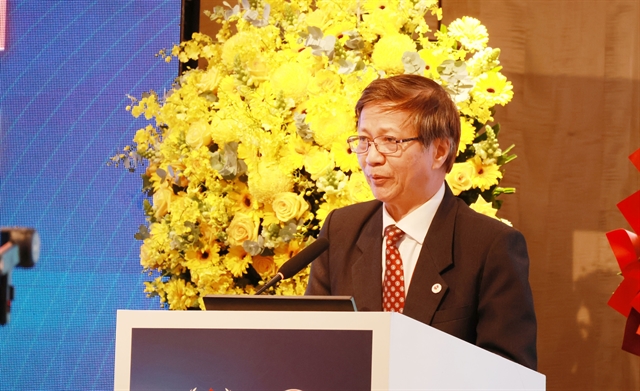 Features
Features

Married couple Đặng Văn Trịnh and Phạm Thị Cúc are the last potters still earning from pottery at Mỹ Thiện Village in Châu Ổ Township of the central Quảng Ngãi Province.
 |
| Love of pottery: The entrance gate of a private terra-cotta museum is decorated with products of Mỹ Thiện pottery. — VNS Photo Công Thành |
By Công Thành
Married couple Đặng Văn Trịnh and Phạm Thị Cúc are the last potters still earning a living from pottery in Mỹ Thiện Village in the central province of Quảng Ngãi.
They live well from the skills passed down from their ancestors over five generations, all of whom worked in the 400-year-old terracotta village, 20 kilometres from provincial capital city of Quảng Ngãi.
Most people in the township earn money from quick profitable businesses or services brought about by rapid urbanisation and industrialization.
Trịnh, 56, and his wife have spent half of their lives working with pottery, and their products are still popular as containers for rice and wine or kitchenware among ethnic groups in the Central Highlands region.
“I was born at my grandfather’s pottery on the river bank, and my childhood was spent with clay, rollers and kilns. Potters in Mỹ Thiện Village were major creators of household containers (big vases for water and rice) or indoor decoration in the central province and tribes living in the Central Highlands in 18th and 19th centuries,” Trịnh said.
“Most people in coastal rural and mountainous areas stored rice and wine in terracotta jars or vases for long conservation, while fishermen also kept fermented fish sauces in clay pots for family use year-round,” he said, adding that ethnic groups in the Central Highlands prefer preserving dried food, wine and treasure in big jars.
The 56-year-old potter recalled that the trade was a major breadwinner for all villagers as rice farms were limited with low yields.
In recent years, Mỹ Thiện, situated by the Trà Bồng River, has turned into a busy trading and retail township, and many potters changed trades to make easier money from fashion shops or stalls at Châu Ổ market.
“We are the last potters at the centuries-old craft village,” Trịnh’s wife, Phạm Thị Cúc, 52, said.
“My three children have not followed our trade as they could find jobs that offer better incomes. For us, the craft still holds beautiful memories that helped my family overcome difficult times,” Cúc said.
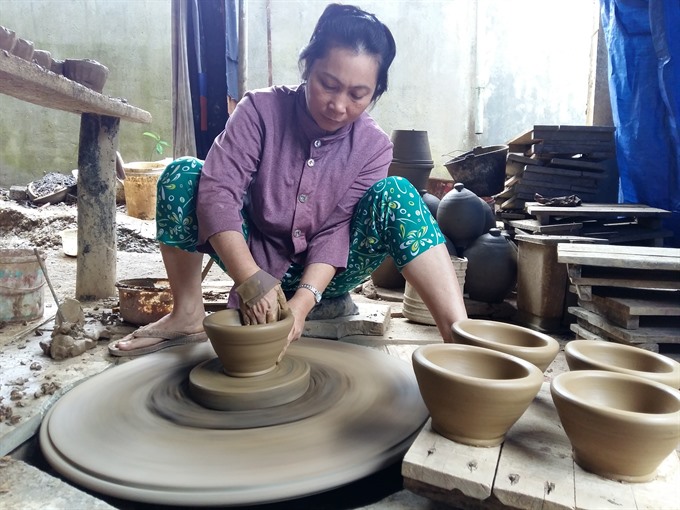 |
| At work: Phạm Thị Cúc forms clay jars and pots at her own pottery in Châu Ổ town. — VNS Photo Công Thành |
Over the centuries, Mỹ Thiện pottery has faced many challenges to the preservation of their ancestor’s heritage, including lack of clay, space, manpower, marketing and design.
Cúc said her family could earn VNĐ12 million (US$530) – a relatively high sum – each month from terracotta products, but clay and firewood accounts for 50 per cent of production costs.
“Clay must come from good quality rice farms, but the rapid development of buildings has narrowed the land area over past decades. Firewood has become rare as logging from the forest was banned, while plastic items (water tanks, pots and basins) have gradually dominated and replaced terracotta homeware,” she explained.
Cúc said her pottery is only produced for orders from ethnic groups (mostly Ê Đê and Ba Na) living in central highlands provinces of Gia Lai, Kon Tum and Đắc Lắk, and mountainous districts (Ba Tơ, Sơn Tây) west of Quảng Ngãi.
Hard job
Cúc said pottery takes a lot of manual skill and most profit comes from labour-saving methods, so young people rarely choose to enter the labour-intensive pottery trade.
“It takes us at least two months of preparation to release a batch of ceramic products. The making of enamel is a crucial factor that creates the unique colour of the products from Mỹ Thiện village,” Cúc said.
She said a mixture of baked shells, clay, straw, rice husks and rock powder are ground by manual millstone into a liquid, which is then applied to the pottery products before they are heated in the kiln twice.
Trịnh explained that the items are put in a big jar to protect the enamel from cracking in the high heat of the kiln.
“We complete the clay work with carved patterns and drying in the sunlight before heating again for a short time. These potteries will then be removed from the kiln for the enamel. The second burning will continue after the enamel soaking process is finished,” he explained.
He said heating the products twice helps them harden, and the enamel turns into a unique dark yellowish brown colour, characteristic of Mỹ Thiện earthernware.
He said all clay products must be burnt in wood-fired kilns at an average temperature of around 1,000 degrees Celsius for perfect pottery.
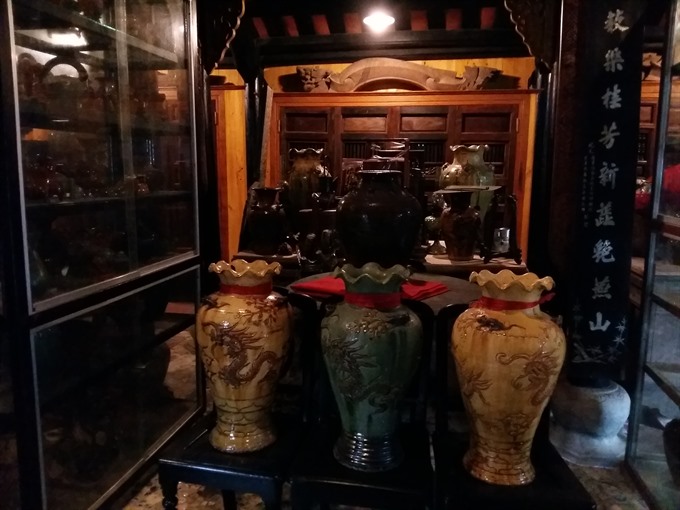 |
| History: A collection of old terra-cotta from Mỹ Thiện Village is on display at a private museum in Châu Ổ town of Quảng Ngãi province. — VNS Photo Công Thành |
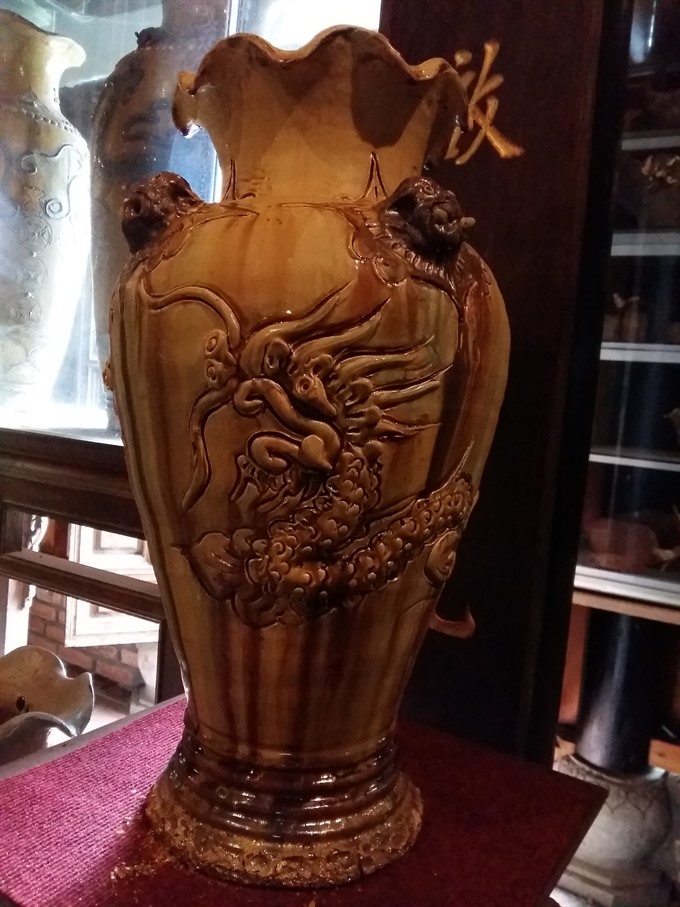 |
| Piece of art: A typical dark brown yellow jar made by a Mỹ Thiện potter. A dragon (with protruding eyes) is the most popular carving among the village’s pottery. — VNS Photo Công Thành |
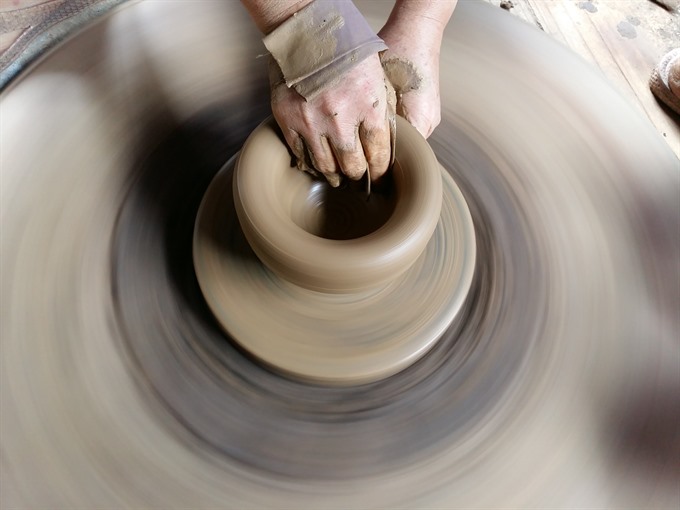 |
| Taking shape: The hands of a potter form a pot on a wheel at a pottery. — VNS Photo Công Thành |
Reviving traditions
Lâm Zũ Xênh, 60, a Chinese-Vietnamese herbalist, whose father is an emigrant Chinese and mother is Vietnamese, has collected and preserved more than 200 ancient terracotta products made by Mỹ Thiện potters.
Xênh, who works in Châu Ổ town, said some items of Mỹ Thiện-made pottery were 100 years old.
“Although I spend most of my time in the herbal medicine shop, I love collecting ancient pottery. I built a house to preserve the old pottery and introduce visitors and younger generation to the history of the terracotta trade in central Việt Nam,” Xênh said.
“Mỹ Thiện emerged as a busy pottery village – providing almost all ceramic household items in central Việt Nam – in the late 18th century with at least 60 workshops. I was so sad to see local potters and their kilns disappear over the last decade when terracotta products could not compete against cheaper and mass produced plastic equivalents,” he said.
He said he persuaded Trịnh to preserve his pottery with a promise of support in marketing and sales.
“If Trịnh dismantles his pottery, the trademark of Mỹ Thiện terracotta will only survive on paper, and the province will lose an ancient trade treasure,” Xênh added.
He said terracotta products need more designs and diversity to maintain a presence in modern life.
The ceramic collector said Trịnh’s pottery could be used as a site for tourists or cultural studies among school students.
He said terracotta could be used for the production of interior decorative items.
Đinh Bá Hòa, a cultural researcher, said Mỹ Thiện hand-made potteries emerged between the 18th and 19th century – the same time as potteries in Bình Định Province, under the reign of King Gia Long (1762-1820).
“A series of potteries were built in central Việt Nam, including Nhạn Tháp, Mỹ Yên, Phù Mỹ in Bình Định. The existence of potteries in the region witnessed cultural exchanges among Chăm people (who ruled the central region between the 3rd and 13th century) and Đại Việt craftsmen (Great Việt, now Việt Nam),” Hòa said.
“Most terracotta goods (jars, pots, vases...) made by Mỹ Thiện craftsmen were used daily among the middle class and rural communities in central Việt Nam. Terracotta products were also very popular among ethnic groups living in the Central Highlands region,” Hòa explained.
“It’s not a luxury product, and decorations on the pottery were simple. Most carvings were of dragons (with protruding eyes), flowers and wild plants. Potters also formed mice, squirrels or toads to stick on the outside to decorate big jars,” he added.
Hòa said the founders of pottery in Mỹ Thiện were believed to come from the central province of Thanh Hóa in mass emigration from northern Việt Nam to the south.
“Migrant potters would combine their traditional trade from northern Việt Nam with Chăm people’s skills and pottery techniques to create the unique Mỹ Thiện pottery,” he explained, adding that jars were regularly used as containers of fish sauce among coastal fishermen.
Hòa said the colour of Mỹ Thiện pottery could be recognised through decorative patterns at Chăm towers in central Việt Nam.
Future
Craftmen in Mỹ Thiện still preserve the primary tradition of pottery as it appeared centuries ago, and all work is still done by hand, according to Hòa.
Hòa suggested that most potteries in Việt Nam survived by making souvenirs for tourists and statues for home and garden decoration.
Đặng Thị Ngũ, 45, a trader in Gia Lai said Mỹ Thiện pots and big jars were major orders among Ê Đê ethnic groups.
She said products from Trịnh’s pottery sold well among Ê Đê, Ba Na and Cơ Tu communities in Gia Lai and Kon Tum. “They (ethnic people) prefer preserving rice, wine, jewellery or costumes in big jars,” Ngũ said.
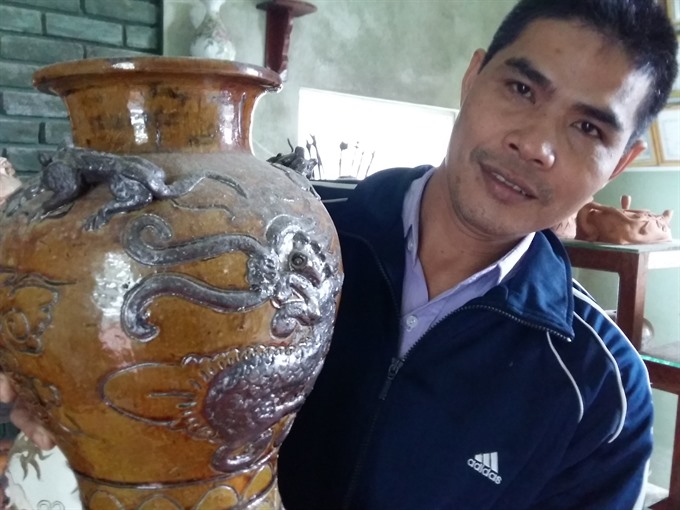 |
| New skill: Ngô Đào Giang shows off his first piece of terra-cotta that he learned from a potter in Mỹ Thiện craft village. — VNS Photo Công Thành |
Ngô Đào Giang, 39, also started his love of clay when he learnt skills from Trịnh’s pottery.
He seeks new decorative patterns and designs for his own jars and pots to decorate gardens and homes.
“I noticed the poor designs of Mỹ Thiện pottery products. All jars and pots were produced repeatedly. Not many design changes were made, while the village has only one pottery still working,” Giang said.
“I made some designs myself and put some vases at my café garden. The outdoor installation of jars and façade decoration would attract visitors to explore the pottery trade,” he said.
Giang said the craft struggled to attract young people because of its low income and hard work, while the rapid urbanisation in Châu Ồ Town left no space for pottery production.
He said the risk of pollution caused by wood burning kilns also posed challenges for the trade making a comeback.
"There needs to be changes in technology and revival planning for the old trade by offering gas or power-burned kilns for better control over the fumes," Giang said.
Meanwhile, eco-tour services should be planned in the village to save hand-made pottery, he suggested.
The central provincial department for culture and tourism has planned Trịnh’s pottery and Xênh’s museum as two destinations in an eco-tour journey in the summer of 2018.
Vice director of the department Huỳnh Thị Phương Hoa said tourists would have the chance to explore the trade at Trịnh’s pottery and museum of terra-cotta antiquities.
She said the pottery and museum would connect with other sites in the province in a chain of destinations.
The province also plans the sea area of Bình Châu Commune – 10km from Mỹ Thiện craft village – and Lý Sơn Islands to form part of a Global Geo-park.
Artisan Trịnh said he hoped that his pottery would lure more people to visit and he would offer young people free training as young potters in the future. — VNS



